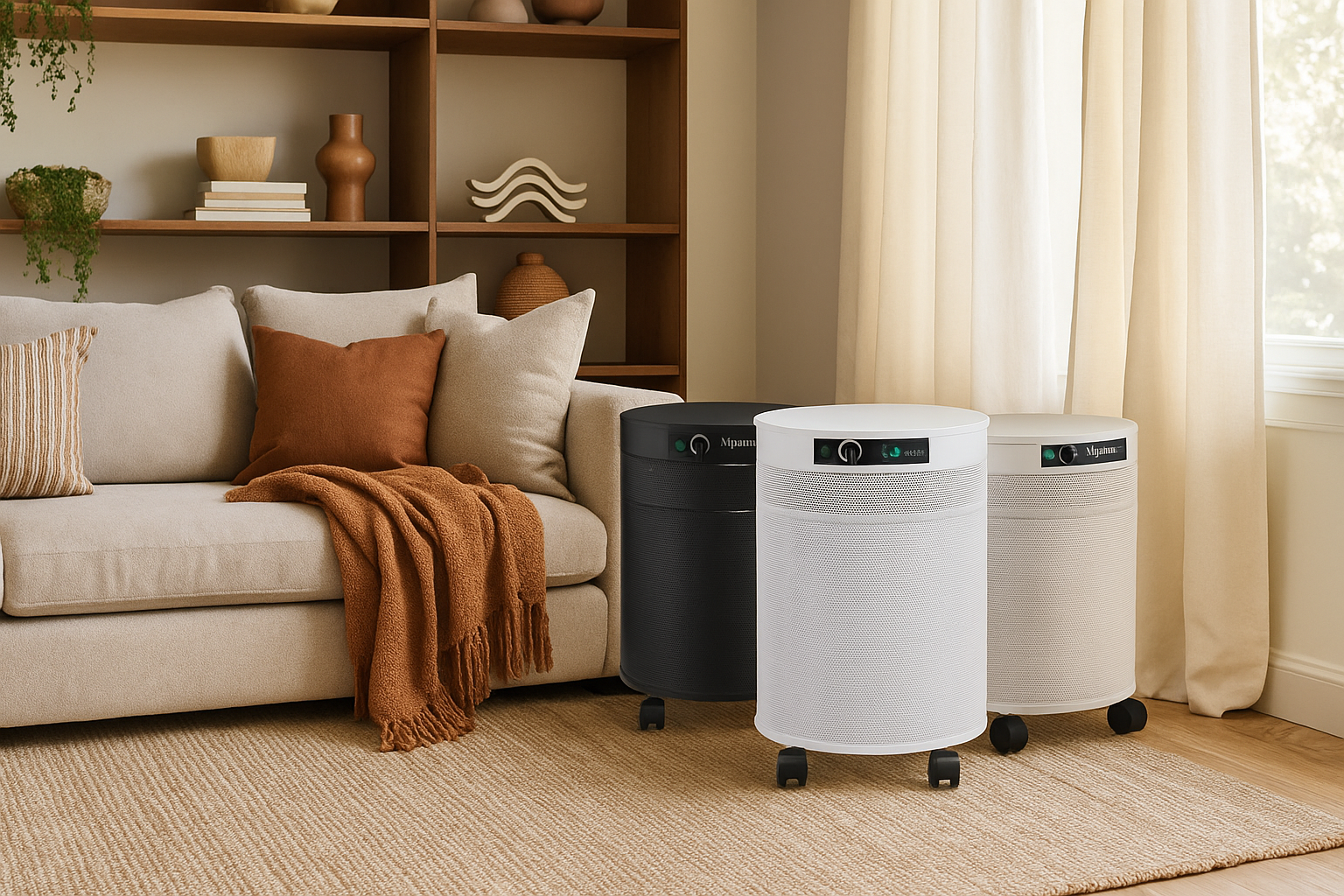In the construction industry—especially on the East and West Coasts—controlling respirable crystalline silica (RCS) dust remains a major compliance and safety challenge. OSHA’s silica standard for general contractors has been in effect since 2017, yet many firms still struggle to implement effective controls without delaying projects or blowing budgets. Portable HEPA scrubbers can support a complete silica-control program, but understanding their proper place in OSHA’s hierarchy of controls is essential.

The Current Silica Dust Regulatory Landscape
- OSHA Standard (29 CFR 1926.1153)
- Permissible Exposure Limit (PEL): 50 µg/m³ (8-hour TWA)
- Action Level: 25 µg/m³
- No new federal silica rules for construction in 2025
- State-Level Developments
- California: In February 2025, Cal/OSHA finalized its general-industry silica standard; construction rules remain unchanged despite temporary standards since December 2023.
- California: In February 2025, Cal/OSHA finalized its general-industry silica standard; construction rules remain unchanged despite temporary standards since December 2023.
Key Takeaway: Effective compliance requires a thorough approach that leverages engineering controls at the dust source.

The Statistics Tell a Compelling Story
- Lives Saved & Illnesses Prevented
- OSHA estimates the silica standard will save nearly 600 lives and prevent ~900 new silicosis cases annually.
- OSHA estimates the silica standard will save nearly 600 lives and prevent ~900 new silicosis cases annually.
- Adoption of Controls
- A February 2025 study in the Annals of Work Exposures and Health found 78% of masonry and concrete workers now use water suppression or local exhaust ventilation at the source.
- A February 2025 study in the Annals of Work Exposures and Health found 78% of masonry and concrete workers now use water suppression or local exhaust ventilation at the source.
- Recent Silicosis Cases
- A May 2024 Cal/OSHA report noted 52 countertop fabricators developed silicosis.
- A May 2024 Cal/OSHA report noted 52 countertop fabricators developed silicosis.
- Cost Savings
- A 2024 industry survey showed complete dust-control systems under Table 1 reduced medical monitoring costs by 22%.
OSHA’s Hierarchy of Controls for Silica
- Engineering & Work Practice Controls
- Primary means to reduce RCS exposure below the PEL.
- Primary means to reduce RCS exposure below the PEL.
- Respiratory Protection
- Required if engineering controls alone are insufficient.
- Required if engineering controls alone are insufficient.
- Written Exposure Control Plan
- Documents all measures taken.
- Documents all measures taken.
- Air Monitoring or Objective Data
- To validate control effectiveness.
- To validate control effectiveness.
- Medical Surveillance
- For workers exposed above the action level ≥ 30 days/year.
- For workers exposed above the action level ≥ 30 days/year.
“Engineering controls at the source are mandatory before considering area air-cleaning.” — Maria Sanchez, CIH
Table 1: OSHA-Prescribed Control Methods
Implementing all Table 1 methods for a given task eliminates the need for exposure assessments. Examples include:
- Stationary masonry saws with water delivery
- Hand-held power saws with integrated water spray
- Walk-behind milling machines with local exhaust ventilation
- HEPA-vacuum collection on drills
Scrubbers with HEPA Filters: Supplemental Measure
HEPA Definition: 99.97% efficient at 0.3 µm (NIOSH, 2022).
Note: Never rely on HEPA scrubbers as your primary control for silica dust.
Key Features of Modern Job-Site HEPA Scrubbers
- Negative-Air Capability
- Creates negative pressure to contain dust near occupied or sensitive areas.
- Creates negative pressure to contain dust near occupied or sensitive areas.
- Multi-Stage Filtration
- Pre-filters for large particles
- True HEPA for fine particulates
- Carbon filters for VOCs/odors (e.g., food & beverage projects)
- Portable Design
- Variable-speed controls and rugged construction for job-site flexibility
“Negative-air machines trap and remove airborne particles but should supplement source controls.”— Deborah Dickerson, Industrial Hygienist
Implementation Strategies That Work
1. Conduct Thorough Exposure Assessments
- Air Monitoring & Objective Data
- Sustained Monitoring: Initial + periodic checks
“If you don’t measure, you don’t know you comply.”
— Robert Chen, CIH
2. Develop a Written Exposure Control Plan
Must include:
- Responsibilities for silica dust risk
- Engineering, work practice, and respiratory controls
- Housekeeping measures
- Area-access restrictions
Review and update annually; make it accessible to all employees.
3. Implement a Multi-Layered Control Strategy
|
Control Level |
Examples |
|
Source Controls |
Wet cutting/grinding, tool-integrated dust collection |
|
Administrative |
Worker rotation, scheduling high-dust tasks off-hours |
|
Supplementary |
HEPA scrubbers, containment systems, wet housekeeping |
|
Respiratory |
Selected per exposure level, part of a full protection program |
Integrated strategies boost PEL compliance by 64%.
— Construction Industry Safety Coalition (2024)
Real-World Application: Success Stories
Hospital Renovation in Boston
- Controls Used:
- Water delivery on all cutting tools
- HEPA vacuums on grinders
- Portable HEPA scrubbers in enclosed areas
- Negative-pressure containment near patient zones
- Outcome: 93% reduction in respirable silica; zero citations in three OSHA inspections.
Occupied Office Retrofit in San Francisco
- Controls Used:
- Full Table 1 compliance
- Barrier containment + negative pressure
- HEPA scrubbers for ambient air
- Continuous exposure monitoring
- Outcome: Silica levels consistently < 25 µg/m³; tenant complaints eliminated.
The Business Case: ROI
- Avoid Citations: Serious violation penalty = $16,550; willful/repeated = $165,514 (OSHA 2025).
- Lower Claims: Fewer respiratory-illness WC claims.
- Higher Productivity: Better visibility → less downtime/absenteeism.
- Reputation: Clients value sites that prioritize safety.
- Cost Recovery: Comprehensive systems pay off in 14–18 months via reduced cleanup, faster deliveries, and compliance savings.
Your Next Steps
- Review your silica-control plan against 29 CFR 1926.1153.
- Implement Table 1 controls for all applicable tasks.
- Monitor controls to verify effectiveness.
- Supplement with HEPA scrubbers where appropriate.
- Train supervisors and workers on equipment and protocols.
- Audit compliance regularly and update your plan.
Since 2017, the industry has made progress—but ongoing vigilance and correct use of the hierarchy of controls remain vital. Consider U.S.-made air purification systems trusted by dust-control professionals; they’re designed for East/West Coast conditions and fully compliant with regulations.
References
- OSHA. (2016). Final Rule for Occupational Exposure to Respirable Crystalline Silica 29 CFR 1926.1153.
- OSHA. (2025, Jan). Annual Increases in OSHA Civil Penalties for 2025.
- Cal/OSHA. (2025, Feb). Final Respirable Crystalline Silica Regulation.
- Dickerson, D. E., & Goldberg, A. J. (2025). Annals of Work Exposures and Health, 69(3), 273–283.
- NIOSH. (2022). Hierarchy of Controls. CDC/NIOSH.
- Construction Industry Safety Coalition. (2024). Practices and ROI Analysis for Construction Silica Compliance.
- ACGIH. (2023). Design of Regional Air Pollution and Animals Waste Management Facility.


%20(2).png)


